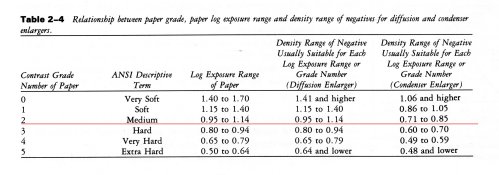whojammyflip
Subscriber
Hi, I've got both a LPL 7700 and a Kaiser VPM enlarger, and with a Stouffer step wedge, dont seem to be able to get higher than contrast of about 3. I dont know whether I am being too brutal in my judgement/seeing tones which dont really qualify as tones though. Has anyone else tried calibrating their prints using a Stouffer step wedge?
My definition of the first non pure white tone is that I can see a boundary between the step and the last white tone, and for the z1, near max black, I can still read the Stouffer numbers. I'm using the step wedge T2115, which I guess stands for 21 steps at 0.15 log10 density units. I dont seem to have any problem getting very long tonal ranges though out of the LPL 7700 it looks like I can get a huge density range. I'm using relatively fresh MG developer for 1 minute in trays, and a mix of pearl and gloss MG IV paper. I'm wondering whether I should just use the filter tray in the Kaiser enlarger and Ilford filters.
My definition of the first non pure white tone is that I can see a boundary between the step and the last white tone, and for the z1, near max black, I can still read the Stouffer numbers. I'm using the step wedge T2115, which I guess stands for 21 steps at 0.15 log10 density units. I dont seem to have any problem getting very long tonal ranges though out of the LPL 7700 it looks like I can get a huge density range. I'm using relatively fresh MG developer for 1 minute in trays, and a mix of pearl and gloss MG IV paper. I'm wondering whether I should just use the filter tray in the Kaiser enlarger and Ilford filters.










 .
.


